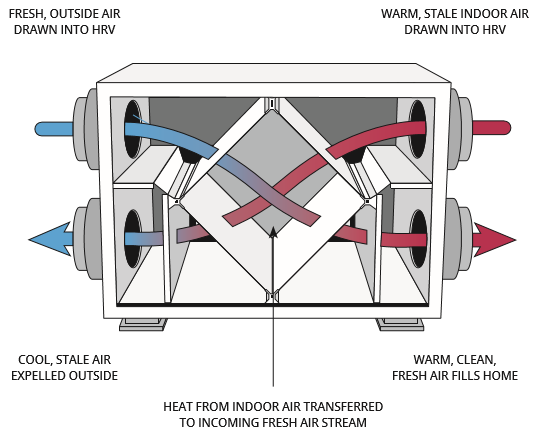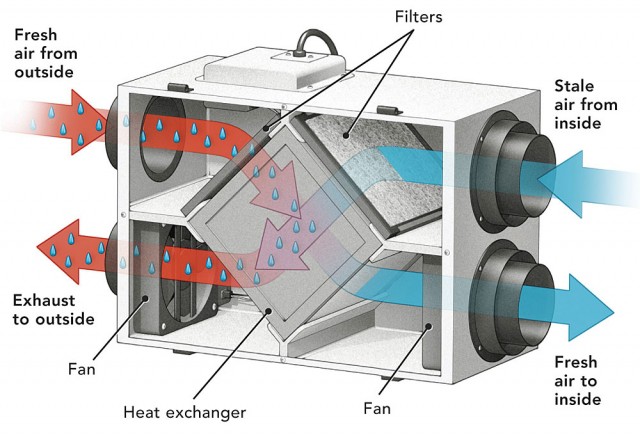Just How Heat Recovery Ventilation Boosts Indoor Air Quality and Reduces Energy Costs
Heat Recovery Ventilation (HRV) systems play a crucial role in enhancing indoor air top quality while simultaneously lowering energy costs. By successfully exchanging stagnant interior air with fresh outdoor air, HRVs aid keep perfect humidity and lower contaminants. In addition, their capability to recoup warm from outward bound air decreases the strain on heating and cooling systems. As power prices remain to increase, comprehending the complete possibility of HRV systems ends up being increasingly crucial for home owners and organizations alike.
Understanding Heat Recovery Ventilation Solutions

Heat recovery ventilation (HRV) systems play a vital role in improving indoor air high quality, especially in modern, energy-efficient buildings. These systems are designed to move warm from the outbound stale air to the inbound fresh air, consequently lessening energy loss while keeping ideal temperature levels inside. HRVs consist of a warm exchanger, fans, and ductwork, promoting the continuous circulation of air. By getting rid of indoor contaminants and introducing fresh air, HRVs help to stabilize moisture levels, avoid mold and mildew growth, and decrease allergens. The performance of HRV systems depends on their capability to recuperate as much as 80% of the warmth from the exhausted air, promoting power preservation while ensuring a healthy interior atmosphere. Their assimilation is essential in accomplishing sustainable living methods.
The Relevance of Indoor Air Quality
Indoor air quality (IAQ) is a vital variable affecting the health and wellness of owners in any type of environment. Poor IAQ can result in numerous health problems, including respiratory system troubles, allergies, and tiredness. Additionally, it can aggravate status quo such as bronchial asthma. Variables adding to reduced IAQ include contaminants from indoor resources like cleaning up agents, mold, and insufficient air flow. Preserving great IAQ is crucial for promoting a risk-free and comfy living or functioning area. Effective approaches to improve IAQ include normal surveillance of air quality, correct air flow systems, and minimizing making use of harmful materials inside your home. By focusing on IAQ, people can assure a much healthier setting that promotes productivity and total lifestyle.
Power Effectiveness Advantages of HRV Solutions
Many property owners and structure supervisors are progressively identifying the energy efficiency advantages of warmth healing air flow (HRV) systems. By moving heat from exhausted interior air to inbound fresh air, HRV systems significantly decrease the energy needed for home heating and air conditioning. This process reduces dependence on conventional a/c systems, leading to lower power costs. In addition, HRVs assist keep a well balanced indoor climate, stopping extreme home heating or cooling down needs. The capability to recover as much as 90% of the warm from outbound air also sustains sustainability efforts by reducing general energy consumption. HRV systems contribute not only to cost savings but additionally to a reduced carbon impact, aligning with the expanding focus on energy-efficient building techniques.
Setup and Upkeep Considerations
The effective implementation of warm healing air flow (HRV) systems needs mindful consideration of installment and maintenance factors to ensure peak performance. Appropriate positioning of the HRV system is important, as it should be mounted in a location that optimizes airflow while minimizing noise interruption. In addition, ductwork needs to be suitably sized and protected to stop power loss. Routine upkeep, consisting of filter substitute and system cleansing, is essential to secure optimum performance and indoor air high quality. Proprietors should establish a routine maintenance timetable to identify and deal with prospective problems before they rise. Collaboration with skilled professionals during both setup and upkeep stages can boost the long life and effectiveness of HRV systems, ultimately causing much better interior environments and minimized energy expenses.
Real-World Applications and Success Stories
Discovering real-world applications of warm healing air flow (HRV) systems reveals their significant effect on indoor air high quality and power go to this site effectiveness throughout numerous settings. In domestic buildings, house owners have actually reported improved air quality, resulting in fewer allergic reactions and respiratory system issues. Schools implementing HRV systems have actually noted boosted pupil concentration and minimized absenteeism due to much better air flow. Commercial buildings, such as workplaces and retail areas, have actually experienced lower energy expenses and enhanced worker efficiency. A company office in a temperate environment achieved a 30% decrease in energy expenses after setting up an HRV system. These success stories demonstrate that HRV modern technology not only contributes to healthier atmospheres but also offers substantial monetary benefits, making it a valuable investment for numerous sectors.
Regularly Asked Inquiries
Can HRV Equipments Decrease Allergens in Indoor Air?
The efficiency of HRV systems in decreasing indoor irritants largely depends upon their capability to filter and exchange air. HRV Heat Recovery Ventilation. By continually replacing stale air, these systems can considerably reduce irritant degrees throughout indoor environments

Just How Does Humidity Affect HRV System Efficiency?
Moisture substantially affects HRV system efficiency; high degrees can lead to condensation, lowering effectiveness, while reduced humidity may boost air exchange. Balancing humidity is necessary for perfect operation and maintaining interior air top quality.
Are HRV Equipments Noisy During Procedure?
HRV systems can produce varying sound degrees throughout procedure, relying on their layout and installment. Some devices run silently, while others might generate visible audio, especially at higher airflow setups or when badly maintained.
What Is the Ordinary Life Expectancy of an HRV System?

Can HRV Solutions Be Utilized in All Environments?
HRV systems can be used in various environments, yet their efficiency may differ - HRV Heat Recovery Ventilation. In severe temperature levels, changes or supplemental systems could be essential to ensure optimal performance and comfort while preserving interior air high quality